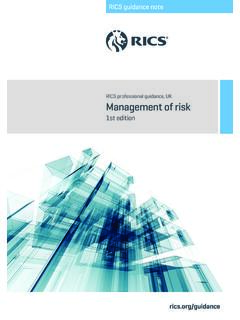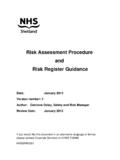Transcription of Managing Risk in Digital Transformation Risk Advisory
1 Managing Risk in Digital TransformationJanuary 2018 Risk AdvisoryManaging Risk in Digital Transformation02 Managing Risk in Digital Transformation03 IntroductionDigital. Is it a buzzword in the corporate world or way beyond that? In the current times, every industry/enterprise has its own definition of Digital and what it means to them. Boards, CIOs, and Executives are extensively talking about going can no longer evade the truth that Digital has become the need of the hour and the most effective enabler for creating a differential and unique competitive advantage.
2 A Digital mindset and the requisite investment of capital, are critical enablers for a successful Transformation trends Several factors have been playing a crucial role in the exercise of Digital Transformation . A few among them have been listed below:Exponentially increasing penetration of smart customer expectations and changing in internet speed and its innovations and inclination towards advanced Technology is slowly being recognized as an important enabler for innovations. Digital Transformation brings forth unmatched opportunities and capabilities for growth and value creation.
3 None of the opportunities, however, can be realized without dealing with the associated risks . Managing risks in the changing era is, thus, critical to an organization s Risk in Digital Transformation04 Managing Risk in Digital Transformation05 Digitalization means different things for different stakeholdersFor an effective Digital environment to meet the desired objective, it is critical to consider risk areas beyond traditional risk. Focus on timely and cost-effective implementation of the Digital initiative, for the respective business teams Effective governance around the Digital transformations to ensure cross functional synergies and eliminate risks arising due to inter dependent processes Risk management framework that can be used by the organization for Managing risks that may arise in any future Digital initiatives.
4 Transforming the tools and capabilities used to deliver services Identify the key stakeholders in the ecosystem aiding the Digital Transformation Risk-based architecture for the Digital enablers, technology, operations, vendors, compliance, security and resiliency Right Digital technologies for different business processes Culture of Digital mindset and a secure usage of the Digital components Define a Digital vision and strategy Conduct a feasibility assessment of the initiatives which can undergo Digital Transformation Adequacy of selection of Digital enablers of the Digital program.
5 In the context of business objectives Setting the tone of risk management at the design stage of Digital program Prioritization of initiatives ensuring minimal impact or disruption of RiskImplementation RiskGovernance RiskStrategy and Vision Implementation Program ManagementEnterprise ViewRisk View Managing Risk in Digital Transformation06 Beyond Traditional Risk and SecurityLaying out the building blocks of the Digital risk strategy is crucial to its success. An immediate step by organizations is to have robust measures around cybersecurity and the easiest approach is to perform typical information security and/or cyber security assessments of systems.
6 The questions which need to be addressed are, Is this enough? Is cybersecurity the only risk to a digitally enabled organization? For an effective Digital environment to meet the desired objective, it is critical to consider risk areas beyond traditional risk. For example, social media is becoming an integral part of marketing, thereby, creating risks to brand value and reputation. Similarly, customer profiling is prominent for better customer experience, but then profiling process should be aligned to protect privacy of customer data.
7 Another important aspect to be considered is Digital resiliency due to large dependency on the technology, the availability of the systems is non-negotiable. There are several other scenarios across different industries and operations that cover other risk domains that could be considered. Managing Risk in Digital Transformation07 Deloitte s Digital Risk FrameworkWe have considered 10 risk areas Strategic, Technology, Operations, Third Party, Regulatory, Forensics, Cyber, Resilience, Data Leakage, and Privacy as the risk landscape in any Digital ecosystem.
8 Based on the applicable risk areas for the Digital initiatives, different control measures need to be designed as per leading standards and industry practices. The critical aspect in defining the controls is to take into consideration the nature and level of digitization in the operations, as most of these areas are at a nascent stage and tightly coupled with systems or manual processes, so there might be constraints to implement the RobotsCustomer LifecycleEmployee LifecycleData LifecycleAsset LifecycleAdditive & vertical system integrationCyber Security & RiskAugmented RealityHorizontal and vertical system integrationIndustrial Internet of thingsBig Data AnalyticsCloudStrategicTechnologyThird-P artyData LeakageRegulatory Forensics ResiliencePrivacyCyberOperationsDigital GovernanceRisk AreasEnterpriseExtended EnterpriseCustomer ExperienceManaging Risk in Digital Transformation08 Managing Risk
9 In Digital Transformation09 Understanding the risk areas is critical to identifying and dealing with all the risks that an organization may be exposed to in a Digital environment. This section explains in brief all the risk areas considered in the of risks arising due to inappropriate controls at vendors/third party operating environment. Key controls would be around data sharing, technology integration, operations dependency, vendor resiliency, arising due to inappropriate handling of personal and sensitive personal data of customer/employee, which may impact privacy of the individual.
10 Key controls includes notice, choice, consent, accuracy, and other privacy environment s capability to enable investigation in the event of a fraud or security breach, including capturing of data evidences which is presentable in the court of to statutory requirements including technology laws, sectoral laws, and of disruption in operations or unavailability of services, due to high dependency on tightly coupled technology. Key areas of consideration would include business continuity, IT/Network disaster recovery, cyber resiliency, and crisis for losses due to technology failures or obsolete technologies.

















